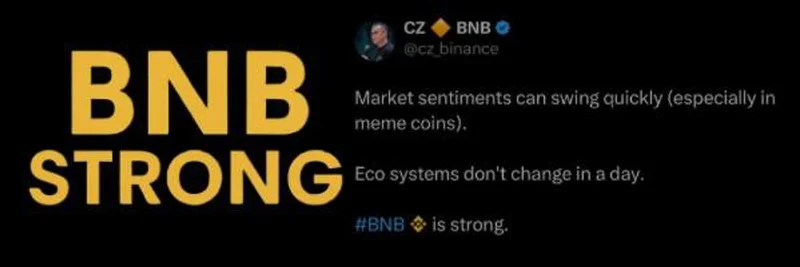If you’ve come across a token called “BNB STRONG” on BNB Chain at contract address 0xd8ee75f571a9e761db37e34c5b33d86d3a104444, proceed carefully. Public, reputable sources don’t show a well-documented project with that exact name and address, and the phrase “BNB strong” is commonly used to describe the performance of the official BNB (Build and Build), not a separate token. Naming that leans on established brands can be a red flag, so thorough verification is essential before you interact or trade.
Why the name matters
BNB is the native asset of the broader BNB Chain, which includes BNB Smart Chain (BSC) for smart contracts, opBNB for Layer-2 scaling, and BNB Greenfield for decentralized storage. The official BNB token has well-known utility (transaction fees, staking, governance, DeFi use) and a mature, transparent burn mechanism. A similarly named, unrelated token could be attempting to piggyback on that reputation.
Simple steps to verify the “BNB STRONG” contract
- Check the contract on BscScan. Confirm you’re looking at 0xd8ee75f571a9e761db37e34c5b33d86d3a104444. Review:
- Token name, symbol, decimals, and total supply.
- Contract source code verification status (is it verified?).
- Ownership status (is the owner address a trusted multisig? has ownership been renounced?).
- Mint and blacklist functions (any ability to mint new tokens or block wallets?).
- Tax/fee logic (buy/sell taxes, max wallet limits).
- Liquidity details (which pools exist; is liquidity locked; for how long).
- Look for audits. Search for reports by reputable firms like CertiK or Cyfrin tied to this exact address. No audit or vague claims are risk flags.
- Assess transparency. Is there an official website, whitepaper, and active social accounts? Are team identities and repositories public? A lack of clear, consistent information is a warning sign.
- Scan for community signals. Genuine projects tend to have sustained, organic community engagement, developer updates, and third-party coverage. Beware of inorganic hype and copy-paste announcements.
Understanding the official BNB for context
- Utility: BNB is used for network fees across BNB Chain, staking and validator delegation, Launchpad participation, and a wide range of DeFi apps and payments.
- Tokenomics: BNB launched with 200M total supply and employs an auto-burn mechanism, with a long-term target of 100M. BEP-95 also burns a portion of gas fees in real time.
- Takeaway: These well-documented mechanics are specific to BNB and do not automatically apply to unrelated tokens using BNB-adjacent branding.
Security checklist before you buy or interact
- Honeypot risk: Test small transactions first. Confirm you can both buy and sell without abnormal failures.
- Hidden taxes: Review contract code and recent trades for high buy/sell taxes or fee changes.
- Privileged functions: Look for owner-only abilities (changing fees, pausing transfers, forcing sales).
- Liquidity lock: Verify locks via on-chain transactions or credible lock services. Unlocked liquidity can be pulled at any time (rug risk).
- Wallet concentration: Check holder distribution. Extreme concentration in a few wallets is risky.
- External links: Only interact through verified, official links. Avoid phishing and fake sites.
Trading and research tips
If you still choose to explore or trade, use tools that centralize security checks and real-time data:
- View and research the token on GMGN.AI: https://gmgn.ai/bsc/token/fV1R5sZ5_0xd8ee75f571a9e761db37e34c5b33d86d3a104444
This page aggregates live market activity, wallet flows, and risk signals to help you spot issues early. GMGN.AI also offers smart money tracking, automated trading via a Telegram bot, and cross-chain analytics for meme tokens. - Confirm contract details and recent transactions on BscScan.
- If liquidity exists on a BSC DEX (e.g., PancakeSwap), always double-check the contract address and slippage/tax settings before trading. Test with a small amount first.
Red flags to watch for with similarly named tokens
- Implicit association with a major brand without clear authorization or official links.
- No audit, no verified source code, or opaque tokenomics.
- Aggressive marketing without technical substance, or recycled content across social channels.
- Sudden changes to fees or transfer rules, or owner permissions that can lock or drain funds.
Bottom line
Public information suggests “BNB STRONG” at 0xd8ee75f571a9e761db37e34c5b33d86d3a104444 is not a widely recognized project within the BNB ecosystem. That doesn’t automatically mean it’s malicious—but the lack of transparent documentation means you should approach with extreme caution. Verify on-chain, look for audits, confirm liquidity locks, and use reputable analytics before you interact.
Helpful resources
- BNB overview: BNB (Build and Build)
- Ecosystem: BNB Chain and BNB Smart Chain (BSC)
- L2 and storage: opBNB and BNB Greenfield
- Token burns: BNB Auto-Burn
- Audits: CertiK, Cyfrin
- Explorer: BscScan
This article is for education and research only and is not financial advice. Always do your own due diligence.


